#Repowering Wind
Explore tagged Tumblr posts
Text
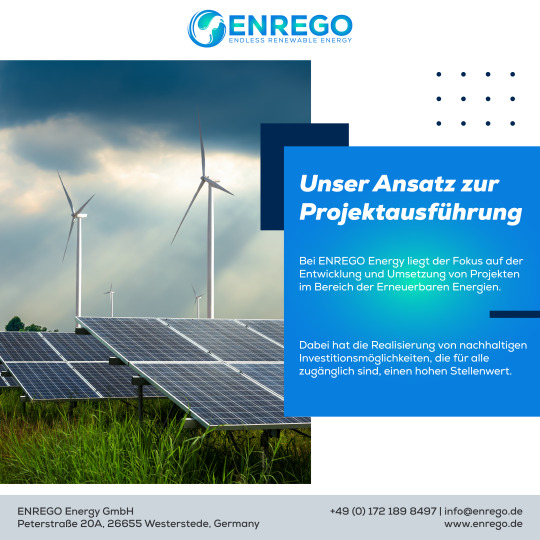
ENREGO Energy: Erneuerbare Energien & Windkraft
Entdecken Sie Wind- und Solarenergie sowie integrierte Energiesysteme – für nachhaltige Erneuerbare Energien mit ENREGO Energy.
#Windenergie#Windenergieanlagen#Windkraft#Windkraftanlagen#Erneuerbare Energie#Photovoltaik#Solar#Integrierte Energiesysteme#Repowering Wind
0 notes
Text
‘Wind Repowering’ Has Rejuvenated Turbines to Boost Gigawatts and Power Millions More Homes https://www.goodnewsnetwork.org/wind-repowering-has-rejuvenated-turbines-to-boost-gigawatts-and-power-millions-more-homes/
9 notes
·
View notes
Text
"Dear EarthTalk: What is wind repowering and why are environmentalists so bullish on it?
—H. King, Mesa, AZ
One of the most common forms of clean energy is wind power. People from around the world could recognize a wind farm from just one look. While wind power has been a staple in renewable energy since the idea’s inception, many of the original and old wind turbines have begun to show signs of aging. Wind repowering aims to fix this, by revamping old turbines with more efficient components, or putting in new, state-of-the-art turbines as a whole. These new components and units can reduce noise, more efficiently power a turbine, and a deliver a higher overall energy output.
Denmark, an early adopter of wind repowering, saw a 1.3 GW gain in capacity and a reduction of 109 wind turbines, enabling substantially increased wind energy production with fewer turbines. This promising data prompted a surge in wind repowering projects, and in 2019, 86 percent of wind energy projects there were classified as “repowered.”
These signs of success and scalability showed other countries the benefits of wind repowering. The U.S, with help from large energy corporations like General Electric, has more than 40 active wind repowering sites, with over 2,500 turbines having some type of renovation. This hefty wind repowering advancement is responsible for four gigawatts of energy, or the power for more than 30 million homes.
It’s no secret how fast wind repowering is growing, but upgrades can be made to many different types of renewable energy. Why do eco-advocates support wind repowering so strongly? Wind repowering has energy, financial, aesthetic and technological benefits. Not only does it make units more efficient, it also removes units that might be aesthetically unpleasing, or in less efficient spots than they could be. Wind repowering also increases the lifespan of turbines by as much as 20 years, and reduces the need for maintenance. Repowered turbines are also quieter, sleeker, and produce considerably more energy.
So, while there are many types of repowering efforts for other renewable energy sources, none are as comprehensive or successful as wind repowering. Not only is it a comprehensive option for revamping clean energy, but it does not require the entry costs that just building new wind farms requires.
The only barrier to wind repowering at the moment is legislation. Bills and policies cannot keep up with the demand for it. Readers should call local officials, or urge any nearby wind farms to look at wind repowering. Spreading awareness is the first and most important step."
-via E: The Environmental Magazine, April 26, 2024
#wind power#renewables#renewable energy#renewable electricity#clean energy#denmark#united states#wind turbines#wind farm#reuse#good news#hope#environment#environmental news
289 notes
·
View notes
Text
Master Sword Pt 2: What half the Chain thinks of the Sword
As I explained in my previous Master Sword post, what Sky thinks of the Master Sword is summed up in this one panel from New Times New Place. But what do the rest of the members of the Chain think of the Master Sword? (FYI, I'm splitting it up and doing Twilight, Legend, and Wild in a separate posts because there's a lot to it.)

Time
In the comic Swords, The Chain is talking about everyone's thoughts on the Master Sword (I'll refer to that comic a lot in this post) and Hyrule, who did not wield it on his adventures, mentions that he is curious about it and Time tells him this:

In Time's case on his adventure he was judged too young too small and the sword changed him to be bigger and older and better able to wield it. Clearly he wasn't a fan of that because in New Time New Place, he says this:

Time recognizes the power and necessity of the Master Sword, but he doesn't agree with it's ways and doesn't want to have anything to do with it anymore because of the trouble its cause him.
Warriors
Maybe I'm missing something, but I've only found one single panel (back in the Swords comic) about Warriors' opinion of the Master Sword when he says this:

Indeed, in his game Hyrule Warriors, that's part of his story arc and the game's plot so I won't say more for game spoiler reasons. But generally, Warriors feels empowered by the sword and there's no indication that he has any negative opinions about it.
Four
In this these panels from Swords...

And these panels from Too Small for the Sword...

We can see that Four has not wielded the Master Sword and does not want to because he knows it is a magical sword and the last magical sword he touched divided him into four pieces in his game, Four Swords Adventures. He doesn't know how the Master Sword would affect him and he doesn't want to know.
Hyrule
Hyrule is another Hero who never wielded the Master Sword because his games predate the Master Sword's invention in A Link to the Past. In Swords, Sky lets him handle the Master Sword and Hyrule is impressed, but he has his own super awesome fire blade and doesn't need the Master Sword.

Wind
There isn't very much about Wind and the Master Sword in LU. He does say this in Swords:
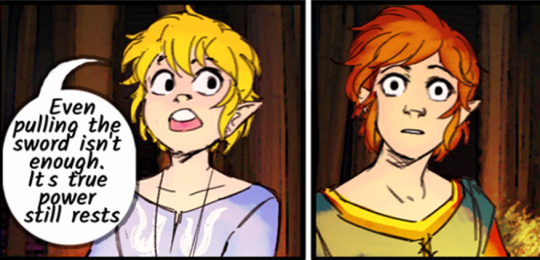
Because in his adventure, when he first drew the Master Sword, it wasn't at full strength and Wind had to find a way to repower it before he could use to fight Ganondorf. Other than that, in Divine Dark Reflections Pt 4, Wind remarks that his primary sword, the Phantom Sword is nothing like the Master Sword, but is useful in it's own way (but he doesn't say whether it's better or worse).
And there you have it folks, half the Chain's opinions in one post. The rest will be coming soon!
#long post#analysis post#linked universe#master sword#lu time#lu warriors#lu four#lu hyrule#lu wild#lu wind#if I've missed something#let me know#I'm writing this series of posts for story research purposes#so I wanna make sure I got it right
156 notes
·
View notes
Text
The Grand Unifying Wind Dancer Theory
Okay, remember when I talked about Prodigy possibly being the mastermind behind the Quiet Council? Well that theory is trash, because I have a much more fun theory in mind.
Wind Dancer is behind the Quiet Council. Not only that, she's also behind Mr. Friend/Mojo. And through him, she's been manipulating things behind the scenes in a major way.
Sofia vs Mojo
Hey, so you remember how Sofia was put in charge of Mojoworld back in the Krakoa era's X-Factor book? But in later appearances, this is never mentioned again and Mojo is back in control?
Prodigy was part of X-Factor at the time. He'd KNOW Sofia is supposed to be in charge of it. Yet he doesn't even acknowledge that Mojo apparently took it back, despite running into Mojo and knowing him as a threat. No mention of how weird that is. No concern about Sofia, or any thought about her being put into danger or eliminated. Something would have had to happen.
Sure, maybe Sofia could have just texted him and said, "lol I lost control of Mojoworld, my b 🙇🏽♀️" But let's be real: X-Factor and the X-Men would have just gone back and beat Mojo's ass as they always do, and Sofia could reclaim her position at any time. Or literally anyone else could take the job. There's no way Mojo would be left alone.
But what if Sofia never lost her role? What if she's still in charge, and is just letting Mojo manage? Or maybe he's a pawn? Mojo might be up for it; Sofia would be in charge on paper, but if she's letting him do whatever he wants and command everyone like normal, it's not a big deal. In fact, he'd feel like he's getting one over the X-Men.
All Mojo has to do is... what he's been doing before. Which is torturing mutants and broadcasting their suffering. Business as usual.
Now, this only makes sense if Sofia wants mutants to suffer, and for their suffering to be seen. But why would she want that? It doesn't make sense! The only mutants who would approve of it are the Quiet Council.
The Quiet Council
The new Quiet Council are a group of mutants who are trying to create a new Krakoa, which they will rule over as leaders. Notably, they are purposely sabotaging mutants, are having them targetted, and are subtly ensuring that they are oppressed by humans. Their ultimate goal is to drive a wedge between humans and mutants further, to the point where mutants will have no choice but to come together in order to survive. Their bad actions are okay, but it's for the greater good: a home where mutants will have sanctuary. It would be way better for mutants than what they have now, which is... Nothing, basically.
But Sofia has a good heart. Would she really let other mutants be sacrificed for the greater good? Well, recall 15 or so years ago, when Wither was arrested. Hellion was able to convince her of the importance of mutants sticking together. (*cough cough Krakoa cough*) She was willing to do what she thought was right - freeing Wither - even though she knew it was illegal and would put the rest of the school under serious scrutiny.
Sofia herself was separated from her friends, until Krakoa came along. It saved her and repowered her. She, of all people, would have a vested interest in Krakoa.
You know who helped get Sofia on that train of thought? On the Wither Wagon? Hellion. The love of her life.
And oh, huh. So the love of her life just so happens to be part of the Quiet Council's leadership. How queer.
If you believe my Prodigy theory, about him also being involved, then that means Sofia's boyfriend AND one of her best friends are controlling things. Funny how that works.
Suddenly, Sofia being part of the Council doesn't seem so out of place. And with her power and influence, she can do a lot of the heavy lifting.
Let's circle back to Mojo. If he's part of the Quiet Council's plans, why is he fighting against Prodigy in NYX #6?
Mr. Friend
Mr. Friend is Mojo's other identity. He uses it to find homeless mutants and refugees from the original Krakoa. Without a home or anyone else to turn to, he takes them in. In exchange, he takes a bit of their DNA to make a drug called MGH - Mutant Growth Hormone.
Mutants under Mr. Friend's care are presumably cared for. They're potential allies for the Quiet Council, as they are Krakoan refugees. They'd want another Krakoa.
But what about the mutants who don't trust Mr. Friend? Well, they would need to ally with other mutants to fight a common enemy, a threat to all mutants. Which is what the Quiet Council want.
Which is what Laura does. She goes to her friends for help. Friends, including Prodigy and Sophie. IE, she's unknowingly going to the Quiet Council.
So you either join Mr. Friend and become part of Krakoa. Or you reject him and turn to the Quiet Council for help, thus becoming part of Krakoa. Or you go to other mutants for help, only for them to be part of the Quiet Council, leading you to become part of Krakoa.
No matter what, mutants joining together is the answer. Krakoa is the only way to survive.
Now what if I told you that the plan goes deeper than that? Because lets look at what MGH does: it makes humans powered and crazy. If people see this and mistake them for mutants (which will be easy, given the mutant DNA in their systems), that makes mutants look bad. So Mojo basically getting people to pay to make his job easier.
MGH is also a steroid for mutants, because it will (at least temporarily) boost their powers. And if you want to protect your nation, you need to be as strong as possible.
You know who used to sell MGH? Vanisher. A mutant who is now working with the government, as he helped them break into Scott's Alaska base. Maybe he's in on the deal and advising Mojo on how to make the drug, while helping the government bust mutants.
Why would he do that? Well, he was killed before. And then he was revived on Krakoa and gladly helped their S.W.O.R.D. team. It'd be very reasonable to assume that he'd want to enjoy the life he once had on Krakoa.
Okay, so this is all making sense. But what about Local, Mojo's minion? He's dragging Wolverine: Woman Edition into the mix, but Sofia's wouldn't want Laura messing up her plans.
Or would she?
Local: Shipping is a Feature, not a Bug
But wouldn't your pawn falling in love with the enemy complicate things? We already saw him trying to rebel against Mojo for Laura's sake. Surely this is a bad thing, right? Who would benefit from this?
Someone who wants to keep Laura away from Julian, that's who. Can't risk the cat-clawed temptress swaying Julian to the side of morality. If anyone can do it, it's Laura. But that becomes harder if she's dating another guy.
Oh, and Local just so happens to have a resemblance to Gambit. AKA, someone Hellion hates, and believes was trying to creep on Laura. Hellion would be furious to know Laura's dating a Gambit clone. If he saw that, he'd think all of his criticisms about Gambit and Laura were completely valid.
Local is there to recruit Laura. Tempt her. If that fails, dating her and complicating things also helps the Quiet Council. His very existence is to either get Laura on their side or, failing that, drive a wedge between Julian and Laura. Not only does this ensure Julian's loyalty to Sofia, but it torpedoes the Helix ship.
Also, in NYX #6, Mojo takes a pot-shot at Laura. This becomes a lot funnier if you think Sofia's behind it.

Not notice how Mojo let her live twice, despite being able to kill her. He chose to let her live. Sofia might be merciful. Or she sees Laura as a future asset. Or she knows that Hellion would never forgive her if she killed Laura. But if Laura is the one who's drifting away from Hellion, then there's no problem.
Of course, this works best if Hellion doesn't know about all this. Nobody tell our boy.
Conclusion: If Local is Sofia's pawn (via Mojo), then him becoming Laura's love interest is mighty suspicious at best, and outright manipulation at worst.
But isn't there another girl? Didn't Hellion also have another love interest a few years back? Shark-Girl, right? There's no point in going after her, she's no big deal. In fact, how would Sofia and Iara even meet?
Oh, they're both part of Dazzler's group in the Dazzler mini. Isn't that a coincidence?
Dazzler: Sinking Ships
We're told how good Wind Dancer is at public relations. She wants to create peace between mutants and humans, but she's always been one to stand up for the little guy. So why would she compromise her morals and encourage Shark-Girl to hide her powers?
Pettiness. She knows Hellion is into her, and he's into her shark form. Sofia, seeing Shark-Girl as a possible obstacle to keeping Hellion, is sabotaging her and making her feel like shit.
This also has the added bonus of making mutants look and feel oppressed. If non-passing mutants see the pressure to conform to human standards, they'll be disillusioned and be more inclined to side with the mutants who accept them. AKA, the Quiet Council.
Also, Dazzler's show was attacked by Mojo in NYX #6. He wanted to use her music to brainwash people onto his side. Brainwashing people to their side would suuuuure go a long way in helping the Quiet Council, wouldn't it?
Sofia is nowhere to be seen, despite Mojo being her minion and the people he's attacking are her friends. How convenient. She knew her friends were coming, yet she never even bothered to interact with them, much less bother to look for them.
Come to think of it, the whole Dazzler tour has been disaster after disaster. They're constantly being sabotaged by outside forces. Dazzler's reputation is in the pits and people are growing to hate mutants more and more. Which is especially sad when you consider that Dazzler's whole goal with the concert was to create peace between human and mutants.
Sure helps the Quiet Council, huh?
Okay, okay. So that's two girlfriends down. Mojo failed to brainwash people, but at least the world tour has gone down in flames. That's all pretty cool and all. We support women succeeding in the work force, even if that work is forcing innocent people to suffer.
But what if Sofia's wicked plan is bigger than that? Media is a world-wide phenomenon, after all. But first, a detour.
X-Force: Don't Shock the Boat
This idea is less concrete, but no less fun.
There's one dangling string: Surge. Though she never dated Hellion, she did kiss him. It was a plot to help Prodigy, but it was still a kiss. And Surge and Hellion were growing to respect each other.
She can break up David and Tommy, but she can't get Prodigy to get back with her if he's already dating Dante. As much as Sofia loved her friend, she had to go. She poses a risk to Sofia's dominion over Hellion. She needs her boyfriend/powerful weapon/pawn.
By teaming up with La Diabla, the one behind all the disasters in the X-Factor book, she can ensure her enemies are eliminated. She can ensure mutants are put under more pressure to work together.
Hey, didn't La Diabla interact with Forge and Surge through security footage? That's magical and mysterious.
But manipulating footage, abusing surveillance and interacting with your audience through the media they watch? Just so happens to be Mojo's kind of thing.

They're working together. She's boosting his surveillance.
And so, Sofia funds La Diabla with her millions of Mojobucks. Grants her all the super-technology she has to offer, which could help her advance her alchemy to insane levels.
Oh, and the first fracture just so happens to be exactly where Surge is. How convenient.
Of course, the world ending would not further Wind Dancer's plans... Unless she and the new Krakoa stop them, thus looking like heroes and getting other mutants to trust them. It's a risk, but Sofia would know all about La Diabla's capabilities and weaknesses. And she could sabotage her at any time, by taking away her resources.
Sofia has been backing La Diabla so she can help the Council, AND secretly take out Surge without anyone finding out about it. X-Factor is fine because they can stop La Diabla once she outlives her usefulness to Sofia. Saves Sofia the trouble of doing it herself.
Is it likely? It's not impossible. But let's look at something that's very much likely-erer.
X-Factor
I mean, X-Factor is social media driven. The US government created them as their own personal heroes, under the guise of helping mutant-relations. Really, they wanted their own goverment-sanctioned military force.
Oh, look. The government-run X-Factor is debating on taking more mutant rights away. Sounds similar to NYX.
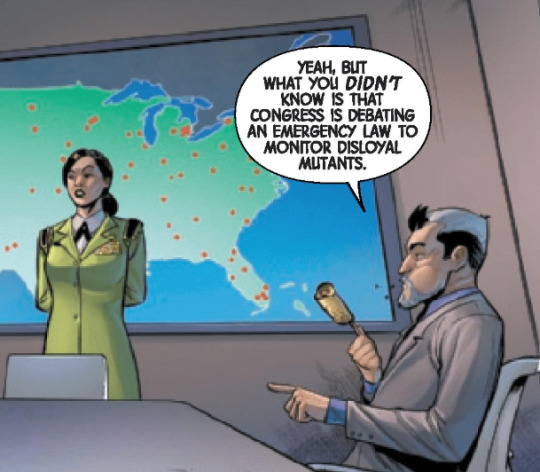
So the US has a team of mutants they're abusing to make themselves look good and protect their country.
But that's just a coincidence! Surely the government can be corrupt, even without the Quiet Council manipulating them. The QC were busy manipulating laws in New York.
Or Empath, Prodigy, Hellion and the Cuckoos were. Mojo is more powerful than them all, and NYX #6 showed that he has brainwashing tech. It'd make the most sense to have Mojo subtly working behind the scenes on bigger projects, while the others work on achieving smaller, more reasonable goals. Otherwise, the Council could have just gone for the government heads right away.
Okay, so the Quiet Council's control extends to the higher levels of the American government. At least, enough to get the ball rolling. With this in mind, it's reasonable to think Sofia is masterminding the government-run X-Factor team. Or at least influencing it.
Why is she fighting the Mutant Underground? Well, they clearly aren't aligned with the Quiet Council. They're fighting the government's injustices. And Sofia doesn't want that. So she's trying to get laws passed in order to not only oppress mutants, but to flush out this possible thorn in her side.
Wow. So Sofia's manipulating things in the Dazzler mini, NYX, AND X-Factor? What's next, is she also behind X-Men?
Yes. Remember how X-Men vol 7, issue 1 teased a new enemy force called 3K? They're making more mutants, AND they reference a word that's very important to Krakoa: Crucible. They want the world to be born anew. All of that just so happens to mesh well with the new Quiet Council.
Now look at the 3K's Chairman. Doesn't his helmet look familiar?
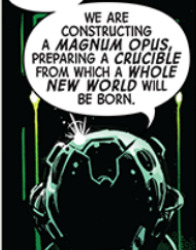

Sofia installed Julian as the leader of 3K, trusting him to enact her will. They're making more mutants to bolster the new Krakoa's forces.
Conclusion
After Krakoa's fall, Hellion, Prodigy and Wind Dancer teamed up to form the Quiet Council and manipulate Empath who, in turn, is purposely sabotaging mutant rights in order to drive mutants together. Using old media, social media, music and Mojo, they're creating a propaganda machine that will make mutants have no choice but to stick to their kind, as everyone else hates them.
Meanwhile, Mojo is also gathering mutants. He's harvesting their DNA to make MGH - not only to make money, but to power up mutants should they ever need to fight.
While all of this is happening, she's removing any obstacles that threaten her control over her boyfriend. She loves him and wants to be with him, I'm sure. But keeping him under her thumb has a lot of benefits, too.
How likely is all of this? Extremely likely. Sofia Mantega is 100% going to be the main villain of the new era. Don't even try to argue with me, it's happening.
But wait, it gets better.
Why is FtA happening? Well, it's no coincidence that it's starting at the exact same time the MCU has begun focusing on mutants. We knew the first Krakoa era was going to end. But they ended it earlier than planned (hence Fall of X rushing in places) so Brevoort can slip into the role and steer the ship. In order to make the line more recognizable with what people are familiar with, in preparation for MCU synergy. The MCU is a major driving factor.
So why get the line ready for MCU synergy, but then make so much of it revolve around Wind Dancer? It only makes sense if she's, say, going to be in a movie.
Wind Dancer will be in a movie. Which is great! ... Until you consider how she's been manipulating media and brainwashing people to get her way.
Conclusion: Sofia is not only assisting the Quiet Council, but she's also trying to take over our world. This is confirmed.
9 notes
·
View notes
Text
Sardegna e Libertà: Eolico: espropri-furti di Stato e Regione a farfalle
6 notes
·
View notes
Text
Germany’s Onshore Wind Surges with Record 4.15 GW Approvals in Q1 2025
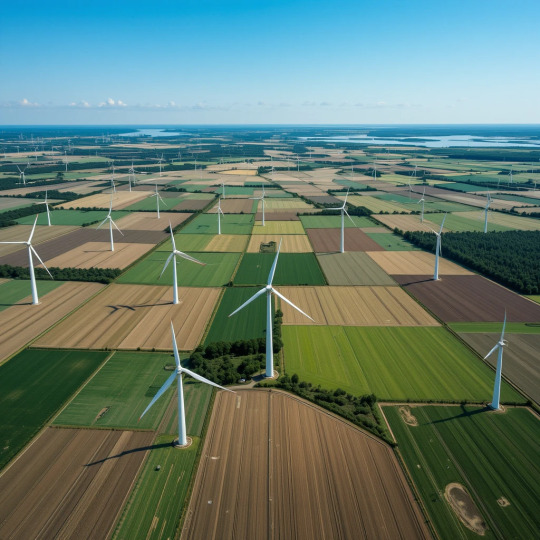
Germany’s onshore wind power sector is experiencing a remarkable resurgence in early 2025, driven by record licensing volumes, accelerated permitting, and a growing focus on repowering. In the first quarter, authorities approved 4.15 GW of new wind capacity-the highest quarterly figure ever recorded and the third consecutive quarter exceeding 4 GW.
Key insights include:
🔹Regional Leadership: North Rhine-Westphalia led with 1.7 GW in new permits, followed by Lower Saxony with nearly 800 MW. These regions remain central to Germany’s wind energy expansion.
🔹Installation Growth: Approximately 995 MW of new onshore wind capacity was commissioned in Q1, the strongest quarterly performance since 2018 and representing nearly one-third of the total capacity added in 2024.
🔹Permitting Efficiency: The average permitting duration has fallen to 18.7 months, a 20% improvement compared to 2024, reflecting regulatory streamlining and enhanced project execution.
🔹Repowering Trends: Upgrades to existing turbines accounted for 29% of new capacity, emphasizing the sector’s commitment to improving efficiency and extending asset lifespans.
🔹Installed Capacity Milestone: Germany now operates over 28,800 onshore wind turbines, with total installed capacity surpassing 64 GW.
🔹Generation Challenges: Onshore wind output declined by 22% year-on-year in Q1 due to weather variability, yet still contributed about 25% of Germany’s electricity consumption.
🔹Renewables Share: Renewables as a whole supplied nearly 47% of Germany’s electricity during this period, underscoring their growing importance in the energy mix.
This strong momentum positions Germany’s onshore wind sector as a cornerstone of the country’s energy transition and climate strategy. Continued improvements in permitting, repowering, and installation rates are essential to meet ambitious renewable energy targets and ensure grid reliability.
Industry stakeholders, policymakers, and investors should view these developments as a positive indicator of Germany’s commitment to a sustainable, low-carbon future.
#OnshoreWind #RenewableEnergy #Germany #CleanEnergy #WindPower #EnergyTransition #ClimateAction #GridModernization
0 notes
Text
Offshore Wind Power Market: Size, Share, Trends, and Forecast (2025-2032)

Offshore wind power is emerging as a cornerstone of the global transition to renewable energy, providing a reliable, sustainable alternative to fossil fuels. Offshore wind farms use turbines placed in bodies of water to harness wind energy, converting it into electricity. As concerns about climate change grow and the need for cleaner energy intensifies, offshore wind power is expected to see substantial growth. This article examines the market size, share, trends, and forecasts for the offshore wind power sector from 2025 to 2032, along with insights into the key players shaping the industry.
Offshore Wind Power Market Size and Growth
The global offshore wind power market has experienced significant growth in recent years, driven by favorable government policies, technological advancements, and increasing demand for renewable energy. Offshore Wind Power Market size is poised to grow from USD 64.27 Billion in 2024 to USD 201.96 Billion by 2032, growing at a CAGR of 15.8% during the forecast period (2025-2032).
Factors driving this growth include:
Government Incentives: Governments worldwide are setting ambitious renewable energy targets, with the European Union aiming for 300 GW of offshore wind capacity by 2050, and the United States targeting 30 GW by 2030.
Technological Advancements: Innovations in turbine efficiency, floating wind turbines, and installation techniques are making offshore wind energy more cost-effective.
Energy Demand: Increasing demand for sustainable energy sources in emerging economies is contributing to the market’s expansion.
Get Your Free Sample Report Here @ https://www.skyquestt.com/sample-request/offshore-wind-power-market
Offshore Wind Power Market Share by Region
The offshore wind market is geographically diverse, with distinct leaders and emerging players:
Europe: Europe remains the dominant region in offshore wind power, responsible for approximately 75% of global offshore wind capacity. Key countries include the UK, Germany, and Denmark, with future growth expected in the Baltic and North Seas.
North America: The United States and Canada are witnessing growing interest in offshore wind, particularly along the U.S. East Coast. The U.S. aims to develop 30 GW of offshore wind by 2030.
Asia-Pacific: China is poised to become a major player in offshore wind, with other countries like Japan and South Korea increasing investments in offshore wind projects. The region is expected to experience rapid growth, with China leading the way.
Other Regions: Emerging markets in Latin America, the Middle East, and Africa are slowly starting to explore offshore wind energy potential, although their contribution remains limited for now.
Offshore Wind Power Market Trends
Several trends are expected to shape the offshore wind market from 2025 to 2032:
Floating Wind Turbines: The development of floating wind turbine technology allows for offshore wind farms in deeper waters, expanding the potential for energy generation. This technology is becoming more viable and cost-effective, particularly in regions with deeper seas.
Energy Storage: The intermittent nature of offshore wind generation requires integration with energy storage systems, such as batteries or hydrogen storage, to stabilize supply and demand.
Repowering and Upgrades: As many existing offshore wind farms approach the end of their operational life, the repowering of these facilities with newer, more efficient turbines will be a key trend. This enables increased energy production without the need to construct new sites.
Public-Private Partnerships: Collaboration between governments and private companies is becoming more common in offshore wind projects. These partnerships are essential for financing and implementing large-scale infrastructure.
Want to customize this report? https://www.skyquestt.com/speak-with-analyst/offshore-wind-power-market
Top Players in the Offshore Wind Market
Several global companies dominate the offshore wind market, driving innovation and development:
Orsted (Denmark) Orsted is a leading offshore wind developer, with an extensive portfolio of operational and planned projects in Europe, Asia, and North America. The company is committed to expanding its offshore wind capacity, with a goal of installing 50 GW of renewable energy by 2030.
Siemens Gamesa (Germany/Spain) Siemens Gamesa is a key player in offshore wind turbine manufacturing. The company has a strong presence in both the European and U.S. offshore wind markets, providing turbines for some of the world’s largest offshore wind farms.
Vestas (Denmark) Vestas is another major turbine manufacturer, known for its large-scale wind turbine solutions. The company is expanding its reach in offshore wind markets, particularly in Europe and North America, and is investing heavily in innovation.
GE Renewable Energy (United States) GE Renewable Energy is a global leader in offshore wind turbine manufacturing. The company’s Haliade-X turbine is one of the most powerful offshore turbines available, contributing to GE’s strong presence in Europe and the U.S.
Equinor (Norway) Equinor is a major player in the offshore wind sector, with several projects in Europe and North America. The company focuses on both fixed and floating offshore wind solutions, with a goal to install 12-16 GW of offshore wind capacity by 2026.
Ørsted (Denmark) Ørsted is another top developer of offshore wind projects worldwide. With an emphasis on sustainability, Ørsted has been a key driver in expanding the offshore wind industry, particularly in Europe.
MHI Vestas (Japan/Denmark) MHI Vestas is a leading manufacturer of offshore wind turbines, specializing in high-capacity turbines for deep-water wind farms. It has secured significant contracts in Europe and is expanding its footprint in North America.
Read Report for Better Understanding - https://www.skyquestt.com/report/offshore-wind-power-market
Offshore Wind Power Market Forecast (2025-2032)
The offshore wind power market is poised for substantial growth over the next decade. By 2032, the market is expected to reach USD 130-150 billion, driven by the following key factors:
Increased Installed Capacity: The global installed capacity of offshore wind is projected to surpass 200 GW by 2032, with Europe continuing to lead but significant growth expected in North America and Asia-Pacific.
Technological Advancements: Innovations in floating wind turbines, energy storage, and grid integration technologies will enhance the efficiency and cost-effectiveness of offshore wind farms, contributing to market expansion.
Investment Growth: As governments and private investors increase funding, offshore wind projects will accelerate. In particular, large-scale projects in the U.S. and Asia will contribute significantly to global growth.
Job Creation: The offshore wind industry is expected to create hundreds of thousands of jobs in manufacturing, construction, installation, and maintenance, boosting economic development in key regions.
Offshore Wind Power Market Challenges
Despite the market’s promising growth, several challenges remain:
High Initial Costs: Offshore wind projects require substantial capital investment, which can be a barrier, especially in emerging markets.
Regulatory and Environmental Hurdles: Obtaining permits and ensuring environmental compliance can be time-consuming and costly, slowing down project development.
Supply Chain Constraints: The offshore wind industry relies on a complex supply chain, and any disruptions, such as shortages in materials or delays in turbine manufacturing, could impact project timelines.
Grid Integration: Integrating offshore wind power into existing grid infrastructure remains a challenge, especially as energy generation moves further offshore.
Offshore Wind Power Market Future Outlook
The offshore wind power market is set to experience remarkable growth between 2025 and 2032. Technological advancements, favorable government policies, and increasing demand for renewable energy will drive this expansion. However, the industry will need to navigate challenges related to high upfront costs, regulatory hurdles, and supply chain issues. The key players in the market, including Orsted, Siemens Gamesa, and GE Renewable Energy, are poised to lead the charge, contributing to a cleaner, more sustainable energy future.
#APAC Offshore Wind Power Market#Europe Offshore Wind Power Market#Middle East Offshore Wind Power Market#USA Offshore Wind Power Market
0 notes
Text
The Race to 11,000 GW: Are We on Track to Triple Renewable Capacity by 2030?
The world is in a race against time to triple global renewable energy capacity by 2030, with a target of 11,000 gigawatts (GW), but current ambitions are falling short. While the world is making strides in renewable energy deployment, a significant acceleration is needed to meet this goal. The COP28 climate summit established the tripling target, aligning with the International Energy Agency's (IEA) Net Zero Emissions by 2050 scenario, which is crucial for limiting global warming to 1.5°C.
Global renewable capacity additions reached almost 560 GW in 2023, marking an unprecedented 64% year-on-year increase. This growth aligns with the annual pace required to reach nearly 8,000 GW by 2030, which matches countries' current policies and estimates. However, even if all countries fully implement their existing ambitions, the world would still fall 30% short of the 11,000 GW target. This ambition gap highlights the urgent need for countries to increase their renewable energy targets and accelerate implementation.
China is the most significant contributor to renewable capacity growth. In 2023, China installed almost 350 GW of new renewable capacity, more than half the global total. If China maintains this pace, it could significantly surpass its existing 2030 ambitions. Outside of China, the rest of the world needs to accelerate its average annual growth by 36% to meet national ambitions. This highlights a significant disparity in renewable energy deployment rates, with some regions and countries lagging.
For advanced economies, the level of ambition needs to increase from a growth factor of 1.9 to 2.5, while for emerging and developing economies, the growth factor should rise from 2.4 to 3.4. This difference underscores the need for varying approaches depending on regional circumstances and capabilities. For example, the Middle East and North Africa (MENA) region has a high growth factor 4.5. Still, in absolute terms, this is only an additional 156 GW, much less than the capacity additions required in Europe, Asia Pacific, and the United States.
The IEA's analysis indicates that tripling global renewable power capacity by 2030 is an ambitious but achievable goal, especially with the record-breaking annual deployment and increasing competitiveness of solar photovoltaic (PV) and wind energy compared with fossil fuels. However, this requires a significant shift in policy and investment, including addressing permitting issues, investing in grid infrastructure, and ensuring system flexibility. Furthermore, significant scaling up of deployment is also needed in Southeast Asia, the Middle East and North Africa, and Sub-Saharan Africa.
The challenge goes beyond setting ambitious targets; it also requires the practical implementation of these goals. This includes accelerating the pace of feasibility studies, permitting, financing, and construction of renewable energy projects. Many countries also need to address challenges such as policy uncertainty, fossil fuel overcapacity, and access to affordable financing.
For example, India, which aims to meet most of its growing electricity demand with renewable energy and achieve 500 GW of non-fossil fuel capacity by 2030, must institute policies to encourage hybrid renewable power plants and support the repowering of existing wind farms. In Europe, which aims to double its renewable capacity, grid infrastructure and flexibility are key challenges. In Southeast Asia, insufficient policy support and unattractive renewable energy tariffs hinder faster renewable capacity deployment.
Several key findings emerge:
Current Ambitions Fall Short: Even with full implementation of existing plans, the world will not meet the 11,000 GW target by 2030.
Regional Disparities Exist: China is a leader in renewable capacity additions, while other countries and regions need to accelerate their efforts.
Policy and Implementation Gaps: Addressing permitting delays, grid infrastructure investments, financing challenges, and policy uncertainty is crucial.
Technology Focus: Solar photovoltaic and wind are leading the growth, but other renewables and system flexibility are also essential.
Global Cooperation is Necessary: Enhanced international cooperation and knowledge sharing are needed to achieve the global renewable energy goals.
The journey to triple renewable capacity by 2030 is challenging, but it remains achievable with increased ambition, accelerated implementation, and a focus on policy priorities. Failure to do so will undermine efforts to meet climate targets and transition to a sustainable energy future.
References
IEA (2024), COP28 Tripling Renewable Capacity Pledge, IEA, Paris https://www.iea.org/reports/cop28-tripling-renewable-capacity-pledge, Licence: CC BY 4.0
IEA (2024), Renewables 2024, IEA, Paris https://www.iea.org/reports/renewables-2024, Licence: CC BY 4.0
IEA (2024), From Taking Stock to Taking Action, IEA, Paris https://www.iea.org/reports/from-taking-stock-to-taking-action, Licence: CC BY 4.0
IEA (2024), Southeast Asia Energy Outlook 2024, IEA, Paris https://www.iea.org/reports/southeast-asia-energy-outlook-2024, Licence: CC BY 4.0
IEA (2024), Achieving a Net Zero Electricity Sector in Viet Nam, IEA, Paris https://www.iea.org/reports/achieving-a-net-zero-electricity-sector-in-viet-nam, Licence: CC BY 4.0
0 notes
Text
GE Vernova lands repower orders for 1 GW of US wind turbines
YaY!! 🌬️
0 notes
Text
The Economics of Wind Turbine Decommissioning: Cost Factors and Market Growth

The global wind turbine decommissioning market is poised for robust growth in the coming years, fueled by increasing investments in renewable energy, ambitious national energy targets, and advancements in wind power technologies. With governments and corporations worldwide focusing on environmentally sustainable energy solutions, the need for effective wind turbine decommissioning services is becoming increasingly critical.
Wind turbine decommissioning involves the complete removal of wind turbines from service and the restoration of land to its original condition. As wind turbines reach the end of their lifecycle, owners must choose between decommissioning or repowering their facilities. Decommissioning often entails the disassembly of turbines, disposal of non-recyclable components, and restoration of the site. This ensures environmental compliance and prepares the land for alternative uses.
The demand for wind turbine decommissioning services is driven by the difficulty in replacing aging turbine components and the high cost of maintaining deteriorating parts. Furthermore, as power purchase agreements conclude, the business case for operating aging wind turbines diminishes, prompting the need for decommissioning.
Visit our report to explore critical insights and analysis - https://www.transparencymarketresearch.com/wind-turbine-decommissioning-market.html
Key Market Drivers
Technological Advancements and Cost Efficiency Innovations in wind power systems have improved energy generation efficiency while reducing the Levelized Cost of Energy (LCOE). These advancements have enhanced the economic viability of decommissioning services, bolstering market demand.
Shift Towards Renewable Energy With the global transition to renewable energy sources, such as wind, solar, and geothermal, investments in sustainable energy infrastructure are surging. This shift is expected to significantly boost the wind turbine decommissioning market in the near future.
Supportive Government Policies National targets, international agreements, and government subsidies aimed at promoting renewable energy have created a favorable environment for the growth of wind turbine decommissioning services.
Regional Insights
Europe is expected to dominate the global wind turbine decommissioning market, driven by substantial investments in renewable energy and its leadership in offshore wind energy. In 2018 alone, Europe decommissioned 421 megawatts of wind power, with Germany accounting for the largest share. The region’s commitment to setting global standards for decommissioning practices positions it as a key player in the market.
The U.S. wind turbine decommissioning market is also projected to experience significant growth, supported by federal tax incentives and state-level renewable energy policies. Meanwhile, the Middle East and Africa are emerging as potential markets, with governments focusing on reducing fossil fuel dependency and promoting clean energy solutions.
Contact Us: Transparency Market Research Inc. CORPORATE HEADQUARTER DOWNTOWN, 1000 N. West Street, Suite 1200, Wilmington, Delaware 19801 USA Tel: +1-518-618-1030 USA - Canada Toll Free: 866-552-3453 Website: https://www.transparencymarketresearch.com Email: [email protected]
0 notes
Text
Hydropower Plant Construction Market Report 2024-2033 | By Types, Applications, Regions And Players
The hydropower plant construction global market report 2024 from The Business Research Company provides comprehensive market statistics, including global market size, regional shares, competitor market share, detailed segments, trends, and opportunities. This report offers an in-depth analysis of current and future industry scenarios, delivering a complete perspective for thriving in the industrial automation software market.
Hydropower Plant Construction Market, 2024 report by The Business Research Company offers comprehensive insights into the current state of the market and highlights future growth opportunities.
Market Size - The hydropower plant construction market size has grown strongly in recent years. It will grow from $18.30 billion in 2023 to $19.60 billion in 2024 at a compound annual growth rate (CAGR) of 7.1%. The growth in the historic period can be attributed to rural electrification, government policies, environmental concerns, environmental concerns, water management.
The hydropower plant construction market size is expected to see strong growth in the next few years. It will grow to $24.51 billion in 2028 at a compound annual growth rate (CAGR) of 5.8%. The growth in the forecast period can be attributed to renewable energy policies, climate change mitigation, grid modernization, energy storage integration, water resource management. Major trends in the forecast period include run-of-river installations, hybrid systems, repowering and upgrading, public-private partnerships, climate resilience.
Order your report now for swift delivery @ https://www.thebusinessresearchcompany.com/report/hydropower-plant-construction-global-market-report
The Business Research Company's reports encompass a wide range of information, including:
1. Market Size (Historic and Forecast): Analysis of the market's historical performance and projections for future growth.
2. Drivers: Examination of the key factors propelling market growth.
3. Trends: Identification of emerging trends and patterns shaping the market landscape.
4. Key Segments: Breakdown of the market into its primary segments and their respective performance.
5. Focus Regions and Geographies: Insight into the most critical regions and geographical areas influencing the market.
6. Macro Economic Factors: Assessment of broader economic elements impacting the market.
Market Drivers - The rising interest in clean energy is expected to propel the growth of the hydropower plant construction market in the coming years. Clean energy is energy obtained from sources that do not emit greenhouse gases, such as nuclear power, hydroelectric power, solar, geothermal, wind, and tidal energy. The rising adoption of clean energy is due to several factors, including the growing awareness of climate change and environmental degradation, improvements in energy storage, and grid integration capabilities. The construction of hydropower plants makes it easier to generate sustainable energy by leveraging the power of water's movement to generate electricity while releasing zero greenhouse emissions. For instance, in June 2023, according to the Energy Information Administration, a US-based principal government statistical system institution in charge of obtaining, assessing, and distributing energy data, the usage of renewable energy in the United States increased modestly to an all-time high of 13.2 quads in 2022, up from 12.1 quads in 2021. Therefore, the rising interest in clean energy is driving the hydropower plant construction market.
Market Trends - Major companies operating in the hydropower plant construction market are focusing on digitization and automation for hydropower plants to strengthen their position in the market. Digital solutions are a collection of devices and applications that use digital technology to meet particular company requirements, such as data analysis, data processing, and operations. For instance, in June 2022, Voith Group, a Germany-based company that constructs hydropower plants, in collaboration with Ray Sono AG, a Germany-based digital solution company, launched the Hydro Pocket, a cloud-based application designed to monitor, analyze, and optimize hydropower stations. Hydro Pocket is a smart, one-stop solution for small to medium-sized hydropower facilities that increases operator efficiency, flexibility, and security. The cloud-based tool handles the system data in a 'smart' way. Maintenance and repair planning is optimized, and problems or unexpected downtime can be eliminated because of the clear picture of assets and support in the form of sophisticated analytical techniques. As a consequence, system management is simplified while communication needs are lowered.
The hydropower plant construction market covered in this report is segmented –
1) By Type: Water Storage, Diverted, Pumped Storage 2) By Capacity: Large hydropower plants, Medium hydropower plants, Small hydropower plants, Other Capacities 3) By Application: City Power Supply, Industrial Power Supply, Military Power Supply, Other Applications
Get an inside scoop of the hydropower plant construction market, Request now for Sample Report @ https://www.thebusinessresearchcompany.com/sample.aspx?id=14397&type=smp
Regional Insights - Asia-Pacific was the largest region in the hydropower plant construction market in 2023. The regions covered in the hydropower plant construction market report are Asia-Pacific, Western Europe, Eastern Europe, North America, South America, Middle East, Africa.
Key Companies - Major companies operating in the hydropower plant construction market are PowerChina Group, Bouygues Construction SA, Sinohydro Corporation, Vinci Construction, Siemens Energy AG, ABB Group, Duke Energy Corporation, Toshiba Corporation, China Three Gorges Corporation, Strabag SE, Statkraft AS, Skanska Group, Hydro-Québec, Verbund AG, Enel Green Power, Webuild SpA, Dongfang Electric Corporation, Andritz AG, Suez Group, RusHydro, SNC-Lavalin Group Inc., BC Hydro, Voith Group, GE Renewable Energy, Astaldi S.p.A., Bharat Heavy Electricals Limited (BHEL), Alstom SA, Innergex Renewable Energy Inc., Voimaosakeyhtiö SF
Table of Contents 1. Executive Summary 2. Hydropower Plant Construction Market Report Structure 3. Hydropower Plant Construction Market Trends And Strategies 4. Hydropower Plant Construction Market – Macro Economic Scenario 5. Hydropower Plant Construction Market Size And Growth ….. 27. Hydropower Plant Construction Market Competitor Landscape And Company Profiles 28. Key Mergers And Acquisitions 29. Future Outlook and Potential Analysis 30. Appendix
Contact Us: The Business Research Company Europe: +44 207 1930 708 Asia: +91 88972 63534 Americas: +1 315 623 0293 Email: [email protected]
Follow Us On: LinkedIn: https://in.linkedin.com/company/the-business-research-company Twitter: https://twitter.com/tbrc_info Facebook: https://www.facebook.com/TheBusinessResearchCompany YouTube: https://www.youtube.com/channel/UC24_fI0rV8cR5DxlCpgmyFQ Blog: https://blog.tbrc.info/ Healthcare Blog: https://healthcareresearchreports.com/ Global Market Model: https://www.thebusinessresearchcompany.com/global-market-model
0 notes
Text










Goldendale Scenic Outlook, WA (No. 3)
The 50 MW Linden Wind Project located in Washington became operational in 2010. EDF Renewables is handling the development of this project.
The project Goldendale, Washington was developed by EDF Renewables for Southern California Public Power Authority. It supplies carbon-free electricity to the SCPPA generation portfolio on behalf of its participating members Los Angeles Department of Water and Power (LADWP) and the City of Glendale.
Construction of the 50 MW project commenced in November 2009 and commercial operation was achieved in June 2010. The final project consists of 25 REpower MM92 turbines.
Source
#Goldendale Scenic Outlook#Goldendale#Klickitat County#Washington#USA#summer 2023#Pacific Northwest#travel#original photography#vacation#tourist attraction#Linden Wind Farm#landscape#landmark#countryside#farm land
0 notes
Text
Blake Nixon: Repowering America’s Electricity Grid at National Grid Renewables for A Clean Sustainable Energy
The solution for a clean and green energy resource that is sustainable in environmental, economic, and social aspects is our natural renewable energy resources. These renewable energy resources cover Solar, Wind, Geothermal, Hydro, and Biomass which are the most common in the world among the lesser-known natural resources. The role that sustainability efforts, initiatives, and practices play in the world today is imperative in addressing the various environmental challenges, in increasing the economic status and growth, and in the societal harmony of enhancing the social and community well-being of a region or nation.

An electricity grid or electric grid powers a country’s infrastructure to meet the needs of the people and the economy. The electric grid ensures the generation of power, its transmission, and distribution of the same to meet energy demands and sustainability goals. With the hope of having a future where the planet is safe, healthy, livable, and green, sustainable goals and initiatives must be established for the well-being of our coming generations. Whatever it is that we do today, will ensure a tomorrow that is prosperous. Therefore in agreement with the need for establishing and leading sustainable efforts and practices in our day-to-day activities to drive our economic growth, reducing the use of non-renewable resources and the already depleting fossil fuels, and enhancing the well-being of our societies and communities for sustainable energy futures, this article will share deep insights into repowering and reinvesting America’s electricity grid by delving into the core areas of an Electric Power Generation company located in North America.
National Grid Renewables, a venture division of the parent company – National Grid, is a renewable energy company headquartered in North America’s Minneapolis, Minnesota. To repower America’s electricity grid, drive the economic and social well-being of societies and communities in the country, and reinvest in a sustainable future, National Grid Renewables is a farmer-founded organization that comes into the picture providing corporations and utilities projects in solar, wind, and energy storage undergoes various stages of development, construction, and operation. This article will also share insights into how the President of National Grid Renewables – Blake Nixon, oversees operations in all the competitive renewable energy activities of solar, wind, and energy storage in America to build clean energy resources that are affordable by the upcoming generations.
The President and His Commitments in Affordable Clean Green Futures:
Blake Nixon has been the President of National Grid Renewables since 2019. After receiving an educational Bachelor’s Degree in Business Administration and Finance from the University of Washington at Seattle, and a General Course at The London School of Economics (LSE), Blake Nixon started his career as an Equity Analyst for a money management firm called Investment Advisors Inc. (IAI), as the Principal of The Rahn Group – the family investment office of Geronimo Energy where Blake managed the venture capital, hedge fund, and the family office’s private equity portfolio, and as the President/Chief Executive Officer of Geronimo Energy – a North American independent company leading renewable power energy projects and developments.
As the President of National Grid Renewables, Blake Nixon is responsible for all the competitive renewable energy activities in solar, wind, and energy storage projects in America, to build a clean and affordable energy future for the coming generations. Blake oversees plans to expand the onshore project portfolio to all the states across America with the launch of the organization’s brand, actively makes efforts to build a clean and affordable energy future by working with important customers like The Hershey Company, committed to the initiatives taken toward achieving a completely sustainable environment that benefits the local and global communities, and passionately working toward promoting sustainable and economic competitiveness. With these commendable efforts, Blake Nixon has successfully driven the venture division – National Grid Renewables by reinvesting in and repowering America’s electric national grid system.
Repowering, Reigniting, and Reinvesting – National Grid Renewables:
National Grid Renewables – an electric power generating organization aims to repower America’s electricity grid system nationwide through their Solar, Wind, and Energy Storage projects, to reignite the local economies of the nation’s society and communities, to reinvest in a sustainable future where the upcoming generations can reap the benefits of an available clean energy resource. The organization develops high-performance renewable energy projects for corporations and utilities and oversees different stages of development, construction, and operation. A farmer-founded green energy enterprise, National Grid Renewables prioritizes its customers, partners, and community members, with values deeply driven into leading by example for an inclusive culture, embracing innovative learning and maximizing efficiencies, addressing challenges and solving problems, and being community-focused.
Successful Solar, Wind, and Energy Storage projects have completed thousands of Megawatts across America leading the company in its transition and transformation journey. With expertise in handling and delegating project development, project construction, project operation, and enterprise, the leaders of National Grid Renewables are strongly rooted and committed to driving sustainability and the economic growth of local communities. With the mission to “leave this world a better place than when we found it”, the organization makes decisions intending to influence the future of the planet’s ecosystem and biodiversity. In environmental aspects, by offsetting CO2 emissions and water usage National Grid Renewables also drives a responsible and leading independent business in America where recycling, repurposing, preserving, and conserving are possible. In Socioeconomic aspects, the electric power generating company provides its support through local charity funding and community volunteering, and creating new jobs for the locals in construction and operations.
National Grid Renewables’s Road in Achieving Sustainability Goals:
Annually, an approximate number of 3.1M metric tons of CO2 emissions are offset, and over 622,000 homes across America use the eco-friendly energy that is generated, transmitted, and distributed by National Grid Renewables. Over 20 years of operation, the organization has created approximately 2,563 jobs in construction and operation, $218M in new tax revenue, $6.7M in charitable funding, and $315M in landowner income.
Recent news on National Grid Renewables is its expansion of its Minnesota Portfolio with two additional solar projects, announcing a $670,000 in charitable through Ohio’s Solar Projects, and successfully establishing the largest Solar Project in Kentucky.
Visit More : https://thebusinessmagnate.com/blake-nixon-repowering-americas-electricity-grid-at-national-grid-renewables-for-a-clean-sustainable-energy/
0 notes
Text


Capturing the Power of Design and Sustainability! 🌿
📍 Located in the #DiabloRange between #Livermore and #Tracy, the #GoldenHillsWindFarm at #AltamontPass is a testament to innovation and clean energy. 🌎
🌟 Design Excellence: The wind turbines, standing tall against the rolling hills, showcase sleek lines and modern aesthetics. Their graceful rotation symbolizes progress and harmony with nature. 💨
📈 Marketing Impact: NextEra Energy Resources, @nexteraenergy @nexteraenergyresources, the visionary behind this project, understands the power of branding. By repowering the aging turbines with more efficient models, they’ve not only increased energy output but also reinforced their commitment to sustainability. 🌟
CleanEnergy #SustainableDesign #AltamontPassWindFarm #NextEraEnergy #LivermoreCA #TracyCA #TracyHills #94551
0 notes
Text
Onshore Wind Energy Market Share, Growth Forecast Global Industry Outlook 2024 – 2033
The global Onshore Wind Energy Market size accounted for USD 52.2 Billion in 2023 and to reach at USD 79.98 Billion in 2033, growing at a CAGR of 4.4% from 2024 to 2033.
Introduction to Onshore Wind Energy
Onshore wind energy is a renewable energy source derived from the kinetic energy of wind captured by wind turbines installed on land. It's one of the fastest-growing sources of electricity generation globally, contributing significantly to the transition towards cleaner and more sustainable energy systems.
Growth Drivers
Environmental Concerns: With increasing awareness of climate change and the need to reduce greenhouse gas emissions, there's growing support for renewable energy sources like wind power.
Cost Competitiveness: Advances in technology and economies of scale have significantly reduced the cost of onshore wind energy, making it increasingly competitive with conventional fossil fuels.
Government Policies: Many governments worldwide have implemented supportive policies, such as renewable energy targets, feed-in tariffs, tax incentives, and competitive auctions, to promote the deployment of onshore wind projects.
Energy Security: Onshore wind energy enhances energy security by diversifying the energy mix and reducing dependence on imported fossil fuels, thus contributing to energy independence.
Market Analysis
Global Growth: The onshore wind energy market has experienced rapid growth in recent years, with installations expanding across various regions, including Europe, Asia-Pacific, North America, and Latin America.
Technology Advancements: Continuous innovation in turbine design, rotor size, materials, and control systems has led to higher efficiency, increased reliability, and reduced maintenance costs, driving market growth.
Market Concentration: Key players in the onshore wind energy market include turbine manufacturers like Vestas, Siemens Gamesa, GE Renewable Energy, and Nordex, as well as developers, operators, and service providers.
Emerging Markets: Emerging economies, particularly in Asia and Latin America, are witnessing a surge in onshore wind installations, driven by rapid industrialization, urbanization, and favorable government policies.
Challenges and Opportunities
Grid Integration: Integrating large-scale onshore wind farms into existing electricity grids presents technical challenges related to grid stability, intermittency, and transmission infrastructure.
Land Use and Community Acceptance: Onshore wind projects often face opposition from local communities due to concerns about visual impact, noise pollution, and potential impacts on wildlife and ecosystems.
Competitive Landscape: The onshore wind energy market is becoming increasingly competitive, with players focusing on innovations in turbine technology, project development, and financing to maintain market share and profitability.
Hybridization and Co-location: Hybrid projects that combine onshore wind with other renewable energy sources like solar photovoltaics or energy storage offer opportunities to enhance system reliability, optimize resource utilization, and reduce costs.
𝐑𝐞𝐜𝐞𝐢𝐯𝐞 𝐭𝐡𝐞 𝐅𝐑𝐄𝐄 𝐒𝐚𝐦𝐩𝐥𝐞 𝐑𝐞𝐩𝐨𝐫𝐭 @ https://stringentdatalytics.com/sample-request/onshore-wind-energy-market/13908/
Market Segmentations:
Global Onshore Wind Energy Market: By Company
Siemens
Envision Energy
General Electric
Suzlon
Vestas
Enercon
Mitsubishi Power Systems
Nordex
Repower
Gazelle Wind Turbines
Clipper Wind Power
Global Onshore Wind Energy Market: By Type
Less Than 500 KW
500 KW To 2 MW
More Than 2 MW
Global Onshore Wind Energy Market: By Application
Utility
Non-utility
𝐂𝐥𝐢𝐜𝐤 𝐭𝐨 𝐏𝐮𝐫𝐜𝐡𝐚𝐬𝐞 𝐌𝐚𝐫𝐤𝐞𝐭 𝐑𝐞𝐬𝐞𝐚𝐫𝐜𝐡 𝐑𝐞𝐩𝐨𝐫𝐭 @ https://stringentdatalytics.com/purchase/onshore-wind-energy-market/13908/?license=single
Future Outlook
Continued Growth: The onshore wind energy market is expected to continue growing in the coming years, driven by declining costs, supportive policies, technological advancements, and increasing demand for clean energy.
Market Expansion: Emerging markets, offshore wind development, repowering of existing turbines, and corporate procurement of renewable energy are expected to drive market expansion and diversification.
Grid Integration Solutions: Innovations in grid management, smart grid technologies, energy storage, and demand-side management will play a crucial role in facilitating the integration of higher shares of onshore wind energy into electricity grids.
Policy and Regulatory Support: Stable and predictable policy frameworks, along with long-term commitments to renewable energy targets, will be essential to sustain investment and growth in the onshore wind energy market.
Conclusion
The onshore wind energy market continues to expand rapidly, driven by environmental concerns, cost competitiveness, supportive policies, and technological advancements. Despite challenges related to grid integration, land use, and market competition, the outlook for onshore wind remains promising, with opportunities for further growth, innovation, and market diversification.
About Stringent Datalytics
Stringent Datalytics offers both custom and syndicated market research reports. Custom market research reports are tailored to a specific client's needs and requirements. These reports provide unique insights into a particular industry or market segment and can help businesses make informed decisions about their strategies and operations.
Syndicated market research reports, on the other hand, are pre-existing reports that are available for purchase by multiple clients. These reports are often produced on a regular basis, such as annually or quarterly, and cover a broad range of industries and market segments. Syndicated reports provide clients with insights into industry trends, market sizes, and competitive landscapes. By offering both custom and syndicated reports, Stringent Datalytics can provide clients with a range of market research solutions that can be customized to their specific needs.
Reach US
Stringent Datalytics
+1 346 666 6655
Social Channels:
Linkedin | Facebook | Twitter | YouTube
0 notes